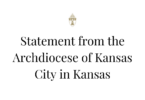
by Karen Mikols Bonar
Special to The Leaven
OLATHE — When she thinks back to her first holy Communion, Marilyn (Schugart) Grover will remember that she received her first Eucharist from the hands of a man who might one day be named a saint.
While currently a Prince of Peace, Olathe, parishioner, Grover grew up in the small, rural town of Timken. She attended Holy Trinity Church, where Father Emil Kapaun was assigned in 1948.
“I received the Eucharist for the first time from his hands,” she said. “I have my little purse with my rosary and prayer book. He would have blessed those items. It’s very special.”
“Everybody loved him,” she continued. “He was such a kind, gentle person. Even at that age, just a kid, I knew that he was somebody special.”

Father Kapaun was granted the title Servant of God in 1993. He served as a chaplain for the U.S. Army and was captured in 1950 and sent to a POW camp in North Korea. In the camp, he continued to serve and minister to his soldiers. He died on May 23, 1951, from malnutrition and starvation at the age of 35.
During Father Kapaun’s military service, Grover’s mother wrote to the priest.
“He found a piece of rice paper in a hut and sat down and wrote a letter to my mother,” she said.
A portion of the correspondence was published in Msgr. Arthur Tonne’s book, “The Story of Chaplain Kapaun: Patriot Priest of the Korean Conflict.”
“My mother knew he loved angel food cake and several times sent them to him in Korea,” Grover said.

When it was announced the Army chaplain was missing, the parish reeled.
“We prayed and prayed and prayed for him. We were hoping that he would come back,” she said. “We remember the day they found out he was not alive. We stood by the window and cried.”
For more than 70 years, Father Kapaun’s body was never identified.
“I thought, ‘I bet we’ll never know where he is buried,’” Grover said.
Yet, on March 4 of this year, it was announced that Father Kapaun’s remains were positively identified by the Defense POW/MIA Accounting Agency among the remains of the unidentified soldiers buried at the National Cemetery of the Pacific in Hawaii.
His remains were then shipped stateside and a funeral was celebrated in the Diocese of Wichita on Sept. 29.

In 1993, the Archdiocese for the Military Services had opened the cause for Father Kapaun’s canonization, and he was given the title Servant of God.
In November 2015, the Diocese of Wichita presented its summary of the documentation of Father Kapaun’s life to the Congregation for Saints’ Causes in Rome.
Now, as a Servant of God, Father Kapaun has cleared the first step in the canonization process.
There are still several more steps, however, including: being declared Venerable, being beatified and then being canonized.
“I keep hoping he will be a saint within my lifetime,” Grover said, “so, I can say, ‘I knew a saint.’”







The story of Father Kapaun is very dear to me as I was born near Pilsen, Kansas and grew up there. I did not know Father Kapaun as I was much younger. I did know his parents very well and his mother was the sweetest happy a person there was. I thank you very much for you stories in the Leaven. I have a sister in Rogers, Ark. and I have sent her you articles of Father Kapaun and she thought the articles were so informative. Again I thank you for all the hard you put in these articles. I live in Lawrence, Kansas